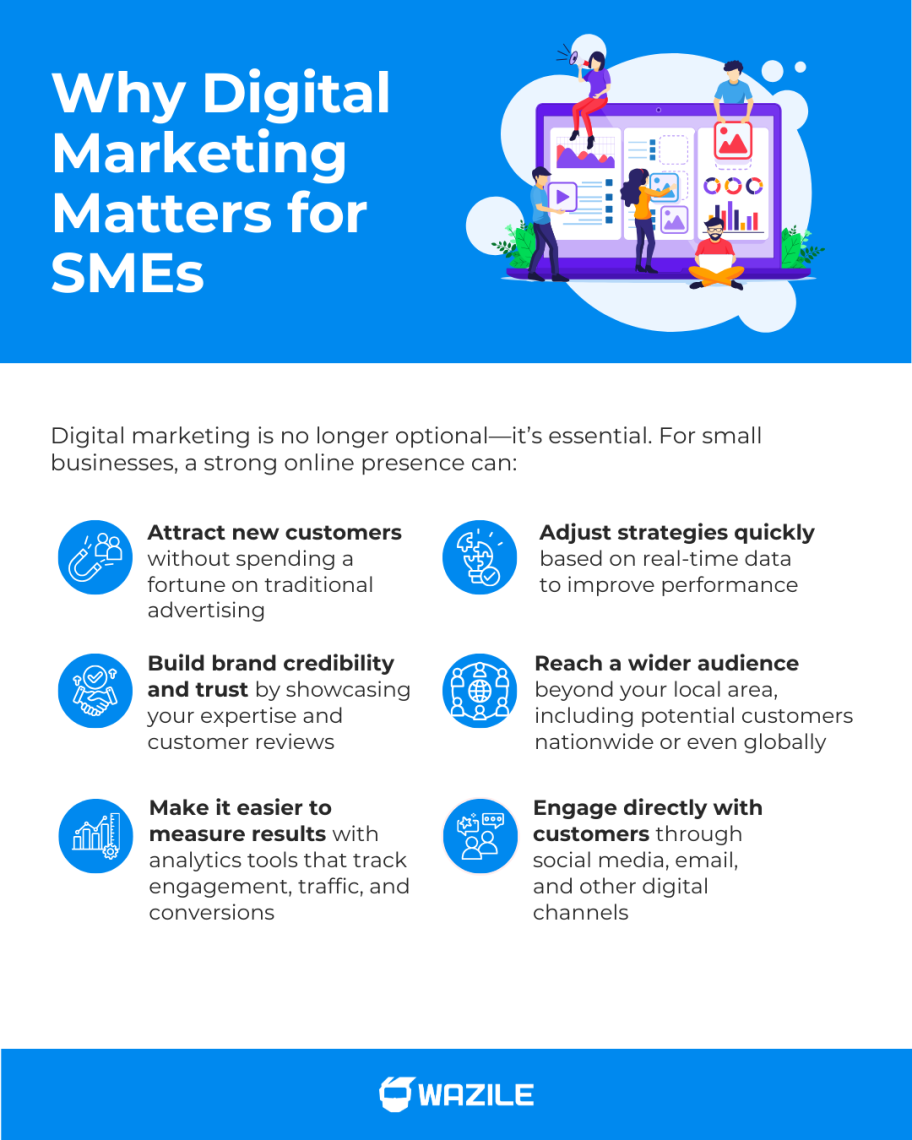
Digital Marketing for SMEs: The Ultimate Step-by-Step Guide
If you run a small business, you’ve probably heard a lot about digital marketing. But where do you start? How do you make sure your limited resources actually lead to results? Don’t worry—we’ve got you covered. This step-by-step guide on digital marketing for SMEs breaks down everything you need to grow your business online without feeling overwhelmed.

Table of Contents
- Why Digital Marketing Matters for SMEs
- Step 1: Define Your Goals and Audience
- Step 2: Build a Solid Website
- Step 3: Optimize for Search Engines (SEO)
- Step 4: Create Engaging Content
- Step 5: Leverage Social Media
- Step 6: Invest in Paid Ads (Optional but Effective)
- Step 7: Use Email Marketing
- Step 8: Monitor and Adjust Your Strategy
- Step 9: Stay Updated
- FAQs: Digital Marketing for SMEs
- Key Takeaways
Why Digital Marketing Matters for SMEs

Digital marketing is no longer optional—it’s essential. For small businesses, a strong online presence can:
- Attract new customers without spending a fortune on traditional advertising
- Build brand credibility and trust by showcasing your expertise and customer reviews
- Make it easier to measure results with analytics tools that track engagement, traffic, and conversions
- Adjust strategies quickly based on real-time data to improve performance
- Reach a wider audience beyond your local area, including potential customers nationwide or even globally
- Engage directly with customers through social media, email, and other digital channels
Even if your business is small, a smart digital marketing strategy can level the playing field with bigger competitors. For tips on building your website first, check out our guide on website redesign or rebuild.
Step 1: Define Your Goals and Audience
Before diving into social media or SEO, you need a clear roadmap. Ask yourself:
- What do you want to achieve online? Sales, leads, brand awareness?
- Who are your ideal customers? Age, location, interests, behavior?
- Where do they spend most of their time online? Facebook, Instagram, Google?
Defining your goals and audience helps you create a digital marketing strategy for small businesses that actually works.
Step 2: Build a Solid Website
Your website is your digital storefront. Make sure it’s:
- Mobile-friendly: Most people access the internet via smartphones.
- Fast-loading: Slow websites lose visitors quickly.
- Easy to navigate: Clear menus, buttons, and calls-to-action (CTAs) guide your visitors.
- Optimized for SEO: Use keywords like digital marketing for SMEs and digital marketing for small businesses in headings, meta descriptions, and content.
A professional website boosts credibility and supports all your other digital marketing efforts. Learn more about website costs in the Philippines and how investing in the right site can grow your business.
Step 3: Optimize for Search Engines (SEO)
SEO (search engine optimization) is key for any digital marketing strategy. It helps your business show up when people search for products or services like yours. Here’s how to start SEO for small business digital marketing and boost your online presence today.
On-Page SEO
- Use relevant keywords in your page titles, headings, and content.
- Write meta descriptions that summarize your page and include your target keywords.
- Optimize images with descriptive file names and alt text.
Off-Page SEO
- Get backlinks from reputable local blogs or business directories.
- Engage in guest blogging on relevant sites to build authority.
By optimizing for SEO, your website becomes more visible, helping potential customers find you faster.
Step 4: Create Engaging Content
Content is the heart of digital marketing for SMEs. It’s how you inform, entertain, and convince potential customers. Some content ideas include:
- Blog posts: Share tips, guides, or news about your industry.
- Videos: Short tutorials, behind-the-scenes, or customer testimonials.
- Infographics: Simplify complex information visually.
For example, a local bakery could share “Top 5 Filipino Desserts You Need to Try” to attract food lovers online. This also helps integrate digital marketing in the Philippines with local audience engagement.
Step 5: Leverage Social Media
Social media is a cost-effective way to reach your audience. Popular platforms in the Philippines include Facebook, Instagram, and TikTok. Here’s a simple approach:
- Choose the right platforms: Focus on where your customers are most active.
- Post consistently: Keep your brand top of mind with regular updates.
- Engage with your audience: Reply to comments, run polls, and encourage sharing.
Using social media strategically is a core component of digital marketing for small businesses, especially for building local communities.
Step 6: Invest in Paid Ads (Optional but Effective)
Pay-Per-Click (PPC) advertising can give your business a quick boost. Platforms like Google Ads and Facebook Ads let you:
- Target specific audiences based on location, interests, or behavior.
- Track ad performance and optimize campaigns for better results.
- Drive traffic to your website or landing pages almost instantly.
Even with a small budget, well-planned PPC campaigns can make a big difference in reaching the right customers and accelerating growth.
Related: What is PPC/Pay Per Click? How It Works, Pros, and Cons
Step 7: Use Email Marketing
Email marketing is still one of the most effective tools for SMEs. Benefits include:
- Nurturing leads and turning them into loyal customers.
- Sharing promotions, updates, or new products.
- Building a personalized relationship with your audience.
Keep your emails short, valuable, and easy on the eyes. Share useful info or offers right away, use visuals or bullet points for quick scanning, and always add clear CTAs like “Shop Now” or “Learn More” to guide readers to take action.
Related: What is a Call to Action (CTA)? Why Every Website Needs One
Step 8: Monitor and Adjust Your Strategy
Digital marketing is not a one-time effort. Track results and adjust your approach:
- Website traffic and user behavior using Google Analytics
- Social media engagement: likes, comments, shares, and click-through rates
- Conversion rates: how many visitors take desired actions
When you track and analyze performance, your SME digital marketing strategy gets stronger.
Step 9: Stay Updated
The digital landscape evolves fast. To stay ahead:
- Follow local digital marketing news in the Philippines.
- Attend webinars or workshops on digital marketing for small businesses.
- Experiment with new tools and platforms to see what resonates with your audience.
Keeping your strategy fresh ensures long-term growth and keeps your business competitive.
FAQs: Digital Marketing for SMEs
1. What is digital marketing, and why is it important for SMEs?
Digital marketing uses online platforms like websites, social media, email, and search engines to promote a business. For SMEs, it’s important because it’s cost-effective, measurable, and helps compete with bigger brands.
2. How much should a small business spend on digital marketing?
There’s no fixed rule, but many experts recommend around 5–15% of your revenue. The key is to start small, test what works, and scale your budget as results come in.
3. Do I need a website if I already have social media pages?
Yes. Social media is great for visibility, but your website acts as your official digital storefront. It builds credibility, gives you full control of content, and works as the hub of your online marketing efforts.
4. How long does it take to see results from digital marketing?
It depends on your strategy. SEO and content marketing can take 3–6 months, while paid ads and social media campaigns can bring results in days or weeks.
5. Can SMEs really compete with big brands online?
Absolutely. Digital marketing levels the playing field—by targeting the right audience, building strong relationships, and being consistent, SMEs can stand out even against larger competitors.
Key Takeaways
- Define clear goals and understand your target audience.
- Build a mobile-friendly, SEO-optimized website.
- Create valuable content that engages your audience.
- Leverage social media and consider paid ads for faster results.
- Use email marketing to nurture leads.
- Track your performance and adjust strategies regularly.
- Keep learning and stay updated with trends in digital marketing.
Digital marketing for SMEs doesn’t have to be complicated. With a clear plan, consistent effort, and the right tools, even small businesses can achieve big results online. Start small, measure often, and scale smartly—your customers are waiting!
Looking to grow your business online? Find the right digital marketing agency in the Philippines and make it happen. Contact us today!

